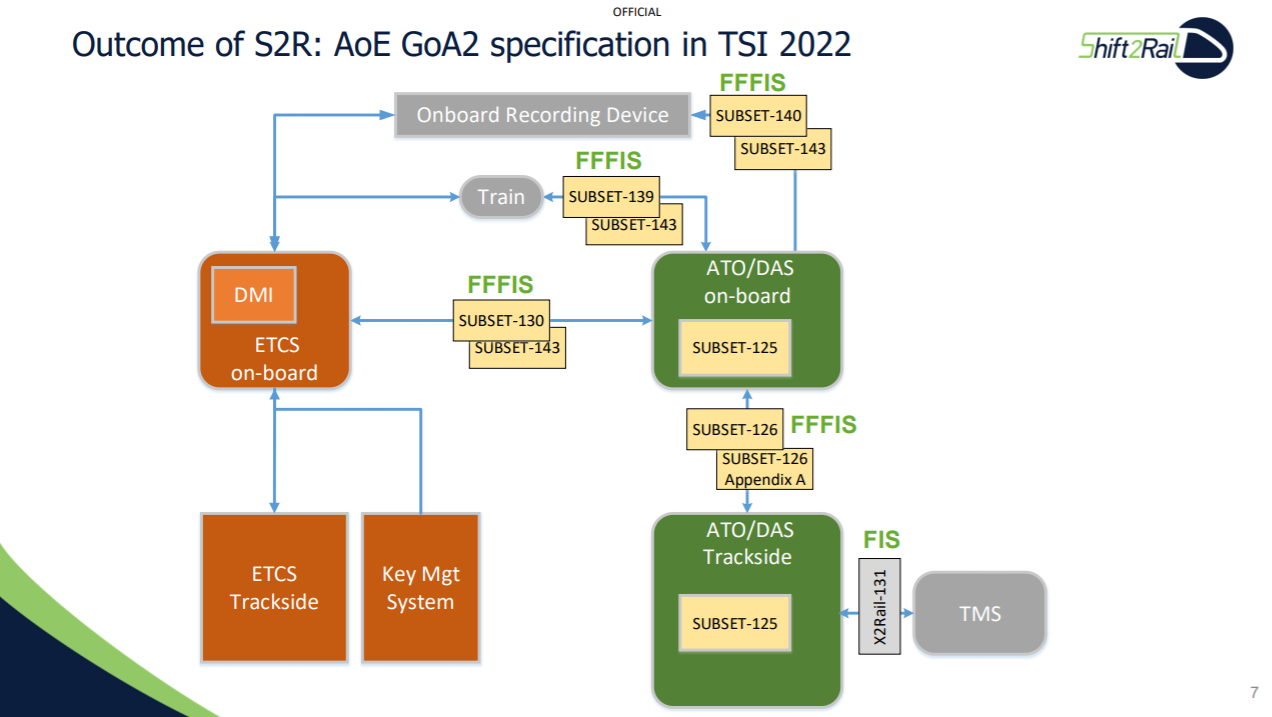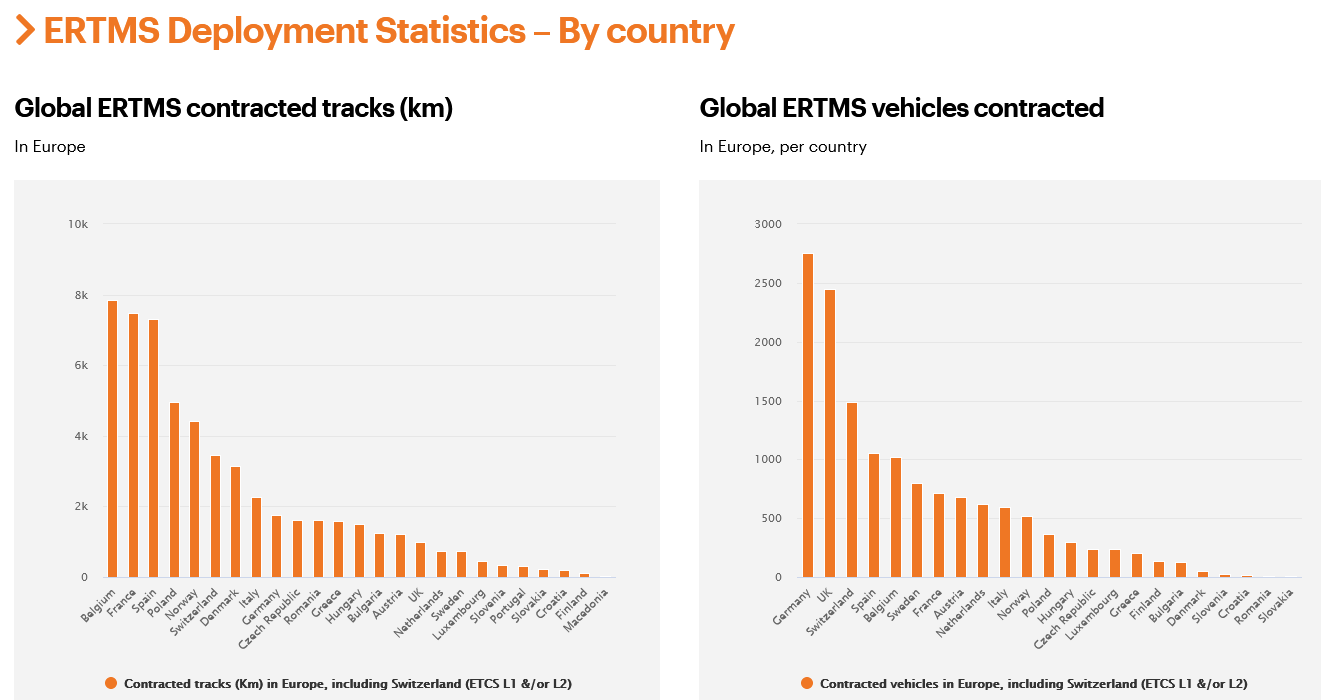The european automatic driving system ATO over ETCS works associated with the european signalling system ERTMS/ETCS. For the complete solution to work, tracks must be equipped with ERTMS/ETCS. Problem : the rollout takes time and money, delaying the use of ATO over ETCS. This situation prevents the benefits of better timetable adherence, and especially reduced energy consumption. While the 2022 energy crisis puts the whole railway sector and the modal shift at risk, ATO over ETCS is a tangible answer.
Migration solutions enabling the use of ATO over ETCS on lines not yet equipped with ERTMS/ETCS are under investigation by railway undertakings. Let’s discover them in this article.
If you are not familiar with ATO over ETCS, I invite you to read this article first.
ATO over ETCS
ATO over lineside signalling by Bastian Simoni is licensed under CC BY-NC-SA 4.0
ATO over ETCS : the european standard solution
The standard solution ATO over ETCS has been specified by an european working group, within the Shift2Rail public-private partnership. This specification activity had following objectives :
- To create the ATO add-on for the european signalling system ERTMS/ETCS,
- To converge towards a standard, interoperable and interchangeable solution,
- To become the unique solution for ATO Mainline use cases within the european Union, by integrating the 2022 revision of the Technical Specification for Interoperability – Control Command and Signalling.
Hence, the standard solution ATO over ETCS, also called ERTMS/ATO is a subsystem of the ERTMS ecosystem. Its System Requirements Specification, SUBSET-125, is indicating that the use of ATO over ETCS without ERTMS/ETCS is out of scope.
ERTMS/ETCS : a long and costly deployment
Since its conception in the 1990’s and its first deployments, the rollout rhythm of ERTMS/ETCS is slow. Although it is meant to replace existing class B systems, and facilitate interoperability, a massive rollout of ERTMS/ETCS is still awaited.
ERTMS/ETCS deployment figures (12/2021) from ertms.net
The German association Allianz Pro Schiene shared in November 2022, helped with SCI Verkehr data, its comprehension of the ERTMS/ETCS rollout plans in some European countries. We can discover that 20% of French and German networks will be covered by ERTMS/ETCS in 2030. Projection of 90% of the network is expected in 2040.
In real terms, this means that from now on to 2040 :
- Class B systems will remain inescapable: software STMs and Multistandard platforms will be a must,
- The ATO over ETCS solution, as defined in 2022, is not massively usable until 2040. Indeed, automatic traction and braking, in presence of a driver, needs ERTMS/ETCS installed both onboard and trackside!
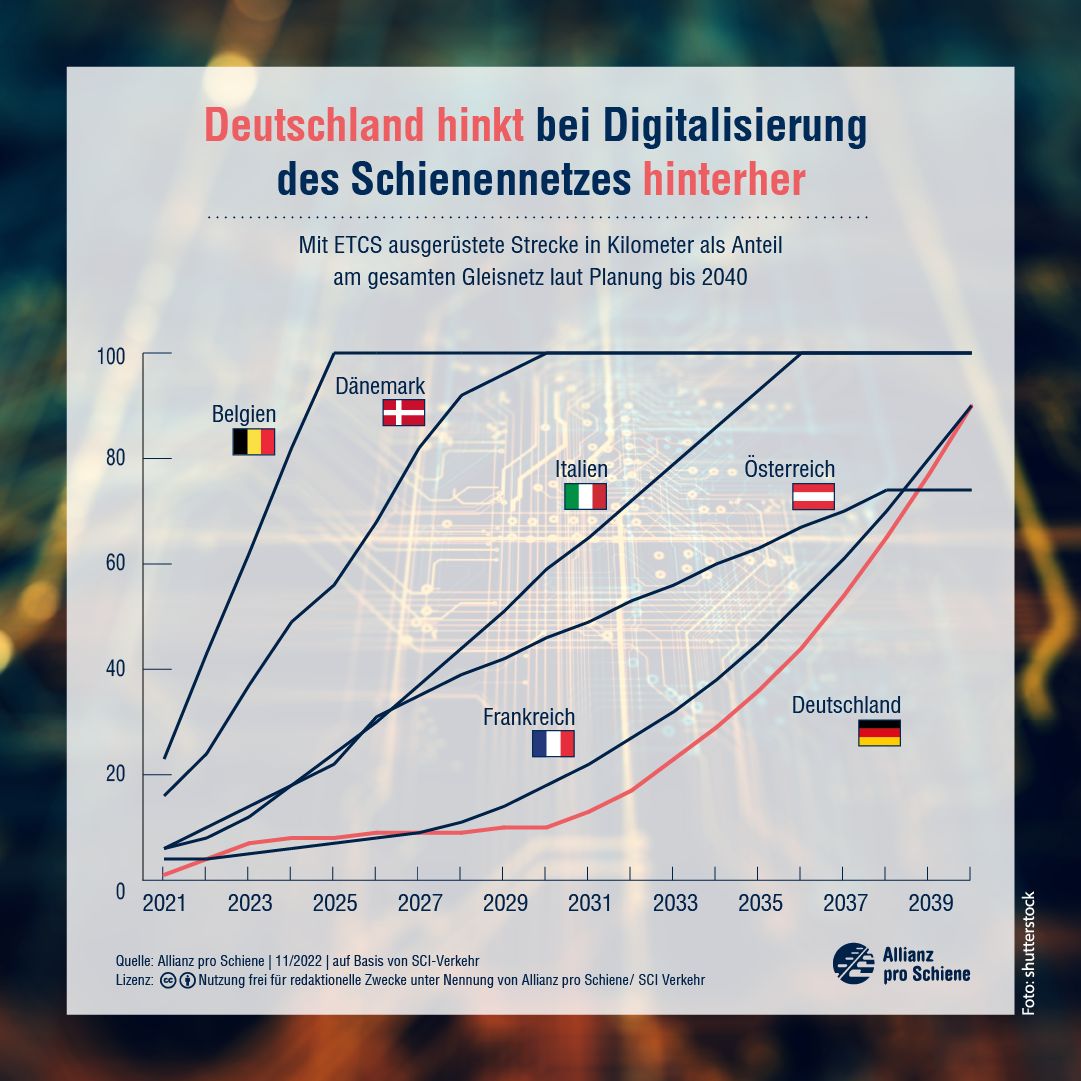
As per specification, the standard solution ATO over ETCS is linked to :
- the equipment of rolling stock with ERTMS/ETCS
- the installation of ERTMS/ETCS on tracks
Railway undertakings could choose using a proprietary ATO solution, linked to their class B system. However this is leading to :
- an extended lifetime of the class B system, considered as legacy and obsolete by the UE. Class B systems must be replaced by ERTMS/ETCS,
- the impossibility to cross borders with the ATO engaged (unless by developping a system capable of interfacing with N class B systems, which is a nonsense in 2022),
- a solution incompatible with future TSI CCS 2022, which will become the law once adopted by UE state members.
The challenge relies in using the standard solution ATO over ETCS and its standard interfaces, without ERTMS/ETCS.
The benefits of ATO over ETCS : now !
Some railway undertakings do not want to wait for the ERTMS/ETCS to be installed, to use automatic driving. SNCF is considering automatic driving on the mainline network for freight and regional passenger trains for 2025. Nederlandse Spoorwegen is experimenting adapted ATO over ETCS to run on their national systems. Railway undertakings are exploring for migration solutions, to launch automatic driving as soon as possible.
In october 2022, M. Alexandre Gallo, CEO of DB Cargo France, warned about rising energy costs, and their impact on rail competitiveness. [5]
Technical solutions do exist to tackle this issue. In 2017, a presentation given at the European Rail Agency, shows two examples enabling energy consumption reduction, by harmonizing the driving profiles with ATO over ETCS :
- 15% potential for intercity,
- 42% potential for suburban (local trains).
Automatic driving is one of the solutions in energy efficiency. Energy efficiency is the reduction of the energy consumption, for the same quality of service. However, as written earlier, ATO over ETCS is unusable on lines that not equipped with ERTMS/ETCS.
Therefore, the use of ATO over ETCS, on lines that are not yet equipped with ERTMS/ETCS, answers a real issue faced by railway undertakings and the modal shift towards rail in general.
ATO over ETCS (over ATB) : the Dutch experiment
Introduction
The Dutch railway undertaking NS, has experienced adapted ATO over ETCS between april 2020 and september 2021. The experiment was done with suppliers CAF Signalling and Ricardo Rail. The objective was to adapt the standard solution ATO over ETCS, and use it on a train and a track not equipped with ERTMS/ETCS. [1]
As explained in the article ATO over ETCS, ERTMS/ETCS is giving to ATO the signalling information that must be respected. If ATO does not, then ERTMS/ETCS applies the emergency braking. In the experiment conducted by NS, there is no ERTMS/ETCS.
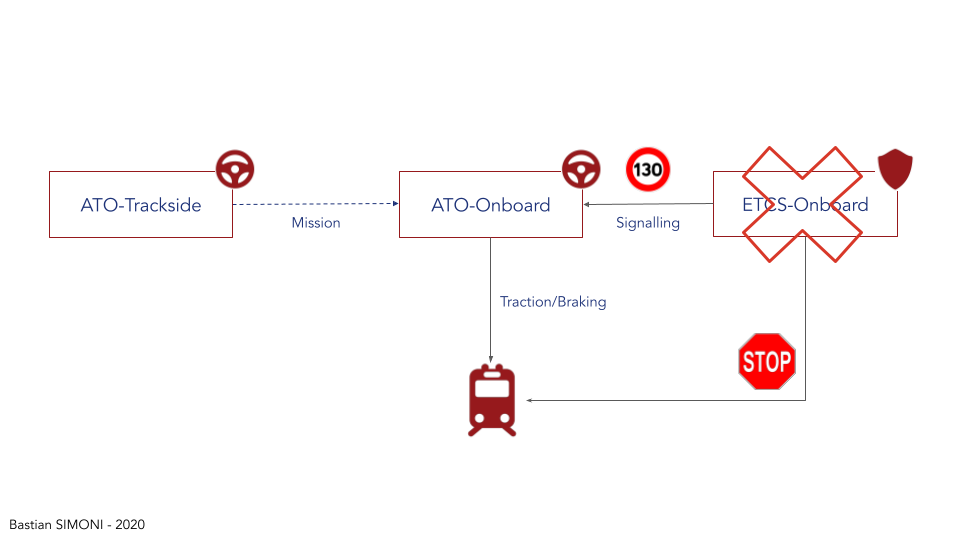
The absence of ETCS onboard is balanced by a dedicated adapter : ATO-ADAPTER. This device fetches all signalling information that is provided to it, whatever the format, and converts it into SUBSET-130 compatible information. NS chose to use three different systems to feed the ATO-ADAPTER :
- Lineside signalling
- Class B system ATB
- Interlocking and block occupancy detection systems
ATO over ETCS (over ATB) in depth
The starting point being the mission to be operated, ATO-OB receives from ATO-TS Journey Profiles and Segment Profiles. Standard interface SUBSET-126 is used for it, and ATO-TS fetches the timetable for Prorail’s timetable system Donna.
New information is added in this interface between Trackside and Onboard : the expected aspect of lineside signals. This extra information is based on SFERA standard. SFERA is a working group within UIC, to complete SUBSET-126 with additional data, to propose a driving assistance system. [2]
Routelint interlocking system has been connected to the system, to retrieve the occupancy state of the blocks. With this information, the system is capable of expecting the state that lineside signalling will present (expected signal aspect).
These data are transmitted regularly from trackside to onboard. The ATO-ADAPTER emulates the onboard ETCS unit, and feeds ATO with signalling information compliant to SUBSET-130. However, this adapter does not provide any safety function. ATB class B system is in charge of it, and applies the braking, if ATO does not respect its warning and protection curves. To avoid any intervention of ATB, the ATO-ADAPTER has to take into account ATB specificities, and to adapt them within SUBSET-130 interface.
Onboard class B system ATB is therefore connected to the ATO-ADAPTER, and provides to it the ATB signalling information (ATB codes). A localization device is also connected (WITbox), enabling ATO-ADAPTER to localize the train on the trackplan. Thanks to this localization information, and the lineside signals static data provided by trackside (signals, expected signal aspect), perception system PER searches within the physical environment the next signal, and provides its state to ATO-ADAPTER.
The driver confirms this signal state on a human-machine interface. Then, ATO-ADAPTER possesses all relevant information, converts it into SUBSET-130 compliant data, and transmits it to ATO.
Thanks to this adapter, the onboard ATO remains compliant with SUBSET-125 and standard ATP/ATO interface SUBSET-130. ETCS-related data within the SUBSET-130 are reproduced by ATO-ADAPTER.
To synthesize the main principles of the system :
- The mission to be operated is completed with additionnal information, provided by the infrastructure manager :
- Location of lineside signals and their characteristics
- Block occupancy state
- Signalling information normally provided by an onboard ETCS unit is reproduced by an ATO-ADAPTER, which fuses :
- Data coming from class B system ATB
- The expected signal aspect provided by trackside, and confirmed by the driver on a human-machine interface
ATO-ADAPTER replaces the ETCS onboard unit, and adapts the different signalling information it can get, into SUBSET-130 compliant information. Furthermore, the adapter takes into account ATB specificities, so to make the ATO drive the train without any ATB intervention.
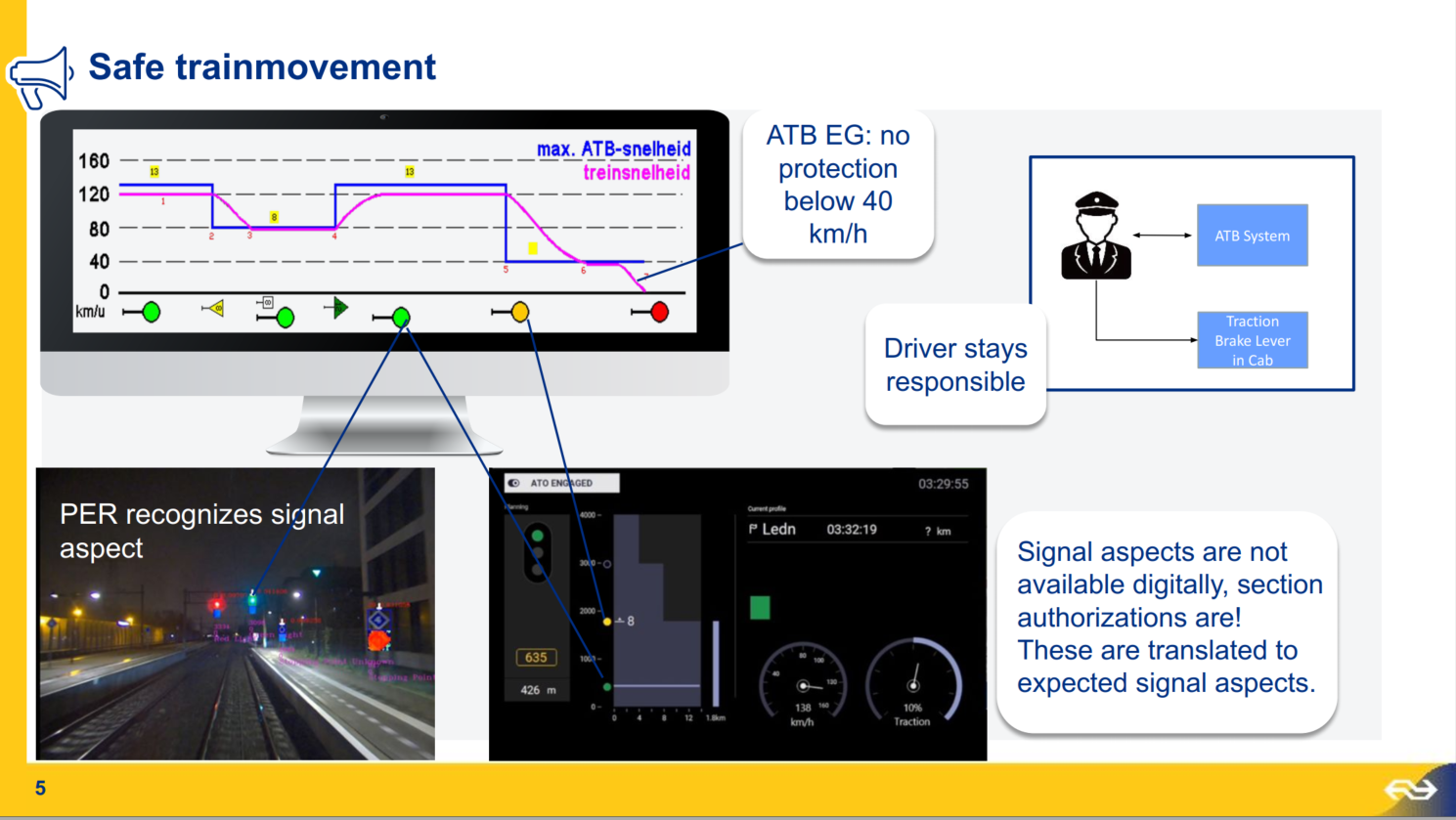
Advantages and blind spots of the NS experimentation
This experiment conducted by NS can be considered as a migration solution, as it reused the standard solution ATO over ETCS with adapters to make it compatible with existing systems. The interfaces around the onboard ATO were therefore respected (SUBSET and SFERA).
However, some aspects can be considered as problematic :
- The link with class B system ATB can encourage extending its lifetime. ATB is considered as legacy by the UE and must be replaced by ETCS.
- The use of static data from the infrastructure manager : what is the availability and quality of the data ?
- The confirmation required by the driver. This opens human factors questions.
Anyhow, the use of ATO over ETCS generic core and its standard interfaces is a first step to deploying ERTMS/ETCS. When the train will be equipped, the ATO-ADAPTER will be removed.
Thus, M. Carlo M Borghini, Head of Europe’s Rail Joint Undertaking, showed his enthousiasm about NS’s experiment, and the opportunity to use standard solution ATO over ETCS, on lines that are not yet equipped with ERTMS/ETCS. [6]
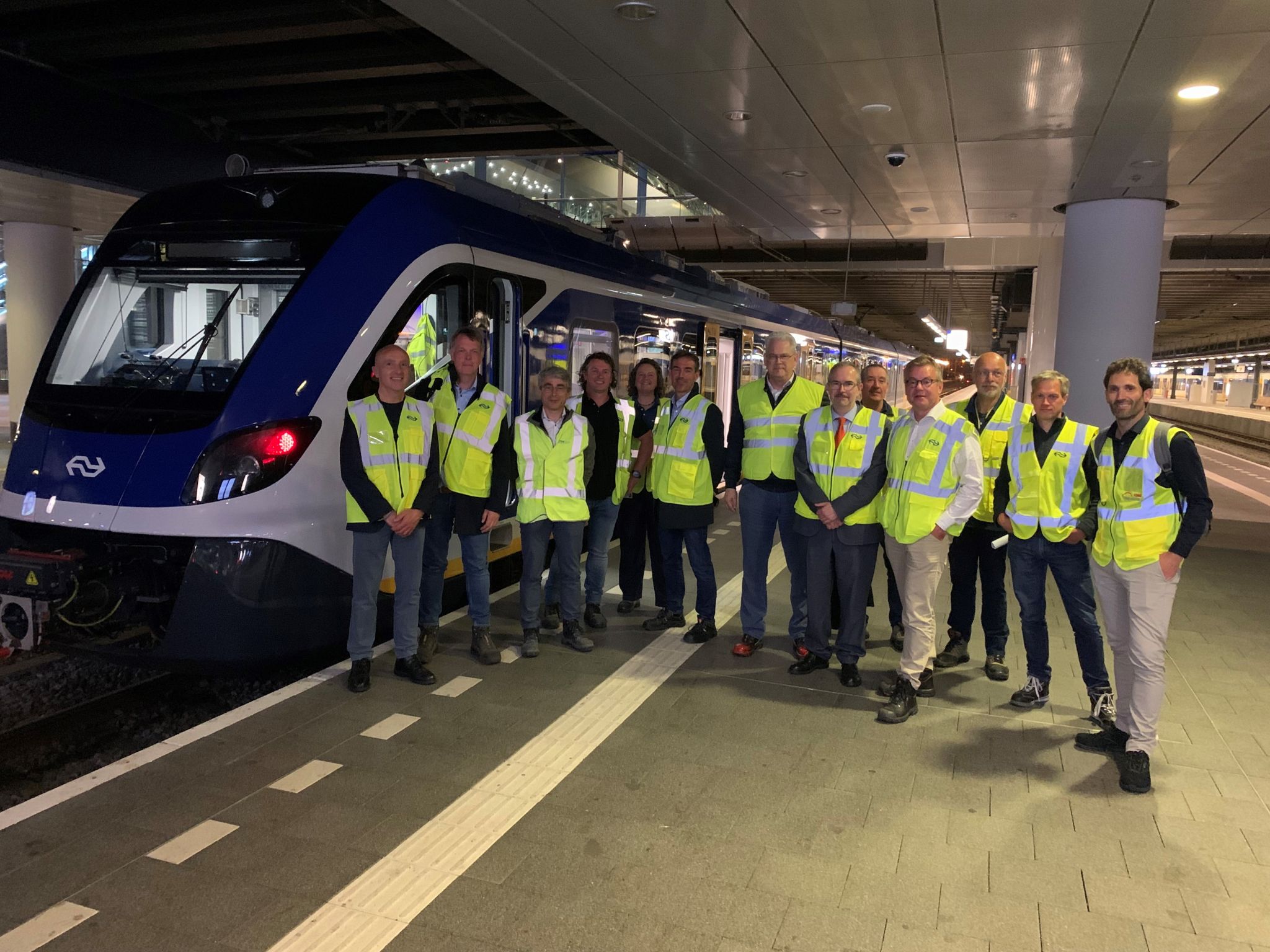
ATO trials in the Netherlands. Credit : Carlo M Borghini.
SNCF’s two pilot projects
SNCF wants to launch mainline automatic driving for freight and regional passenger trains starting 2025. To achieve this, SNCF, ALSTOM and HITACHI are exploring the feasibility to use ATO over ETCS standard solution with adapters, to operate over lineside signalling. Innovation projects are Autonomous Freight Train and Regional Passenger Train.
Both projects are meant to confirm the feasibility of automatic driving with ATO over ETCS, on lines not yet equipped with ERTMS/ETCS, and using only lineside signalling. SNCF already investigated in the past the detection of lineside signalling within project TAS (Transport terrestre Autonome en Sécurité dans son environnement) [3].
In 2022, Autonomous Freight Train project achieved automatic driving using adapted ATO over ETCS solution, over french lineside signalling BAL.
ATO over ETCS-Onboard
A necessary migration period
As we have seen in the beginning of the article, ETCS-equipped kilometers of track remain limited. The deployment dynamic is different in the UE states. This problem is delaying the adoption of standard solution ATO over ETCS.
Investigations performed by SNCF and NS highlight the possibility to use ATO over ETCS with adapters, as migration solution.
Seing an opportunity to accelerate the adoption of ATO over ETCS, the European Commission opened a new program within Shift2Rail, to define a concept enabling ATO over ETCS via a lineside signalling perception and interpretation device. This is seen as a Technology supporting migration to ATO over ETCS. [4]
One possibility is to use lineside signalling perception and interpretation, to feed an evoluted onboard ETCS unit. This concept is very close to current ERTMS/ETCS Level 1, and could be somehow a virtual level 1. This approach is presented in the video below.
Lineside Signalling perception : a new approach to ETCS Level 1
Today, onboard ERTMS/ETCS gets information from trackside by two different means:
- Periodically : via Eurobalises linked to a coder (LEU – Lineside Electronic Unit), that retrieves the lineside signal state. These balises can be completed with infill devices (radio infill or Euroloop). This is ETCS level 1.
- Continuously : via a track-to-train radio link using Euroradio, linking the onboard to the Radio Block Centre (RBC) connected to the Interlocking. This is ETCS level 2, where lineside signalling can be suppressed.
To get an overview of the ERTMS/ETCS system, I recommend you to read this article.
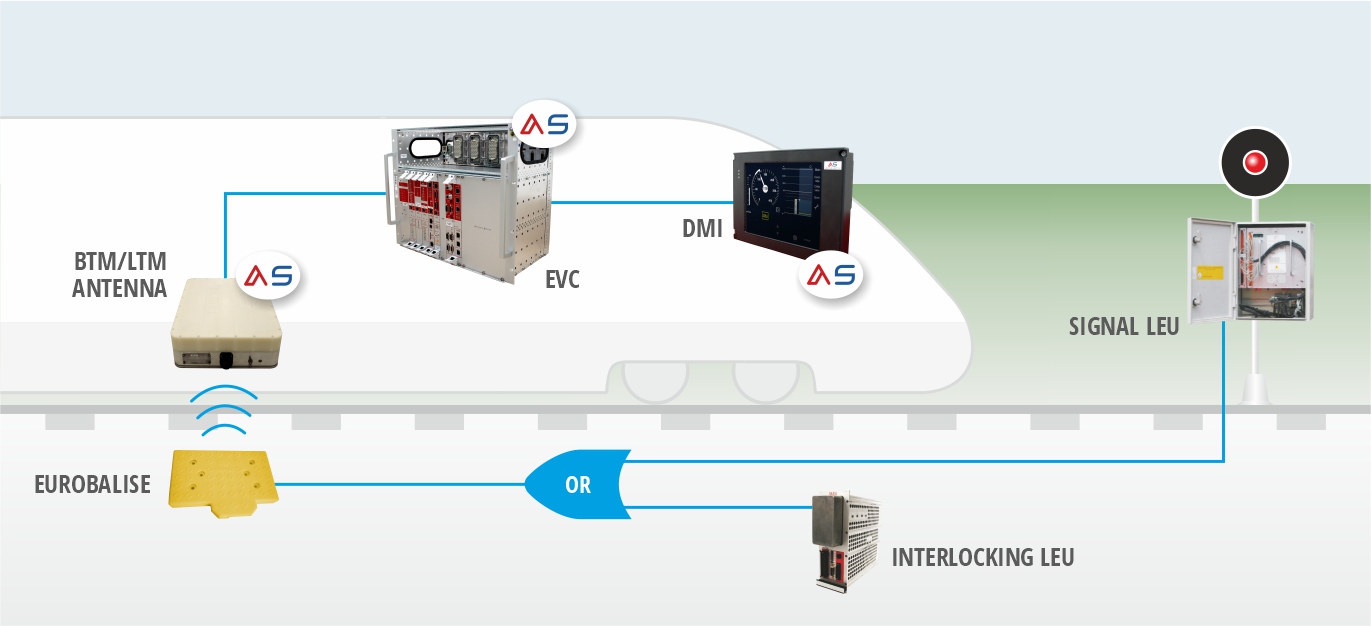
ERTMS/ETCS Level 1.
Credit : MERMEC
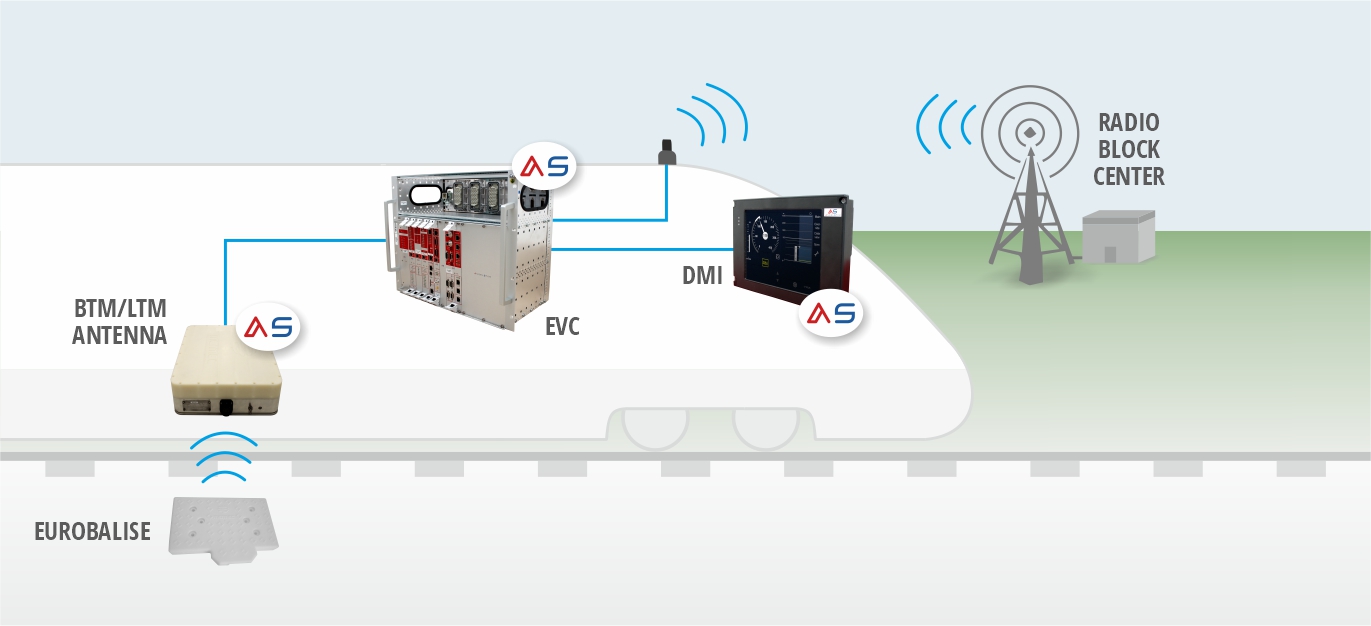
ERTMS/ETCS Level 2.
Credit: MERMEC
In this case study, there is no trackside ERTMS/ETCS. The onboard ETCS has to get its trackside signalling data by another mean. Connection to an existing class B system is forbidden, as ETCS is meant to replace it !
The alternative, that is well deployed, is lineside signalling : static and dynamic signals along the track. The evolved onboard ETCS would have a new interface, to a perception and interpretation device.
In ETCS Level 1, the state of the lineside signal is reproduced within a balise, via a coder : the LEU. The lineside signal state is country specific, and the signalling data transmitted from the balise to the onboard ETCS is standard. It is the goal of ETCS : to enable a train equipped with ETCS, to run on any track in Europe, equipped with ETCS. The application engineering, meant to establish all possible ETCS data for each signal state, is one of the most important steps in a ETCS Level 1 deployment.
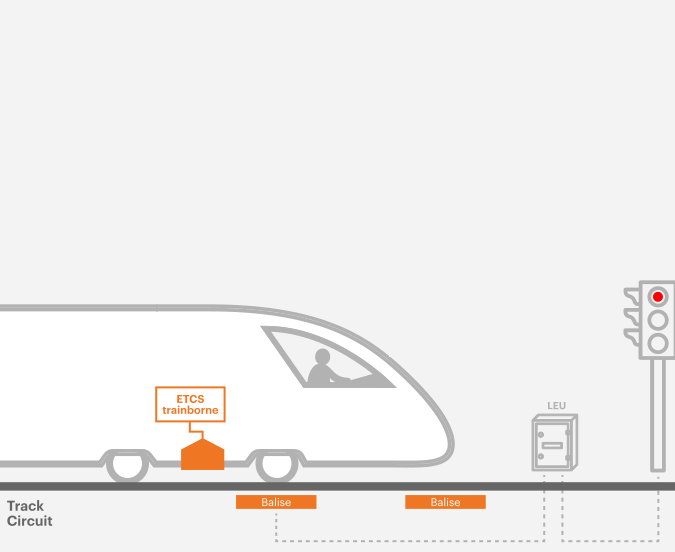
This philosophy can be applied here : the perception and interpretation system can be compared to a balise and a LEU in Level 1. Perception system searches within the physical environment the signals addressing the train, and transmits the perceived state to a signalling converter. This signalling converter adapts the signal state into ETCS standard signalling information, as would a LEU do. The application engineering process done for ETCS level 1 to configure the LEUs can be used to configure the signalling converter.
To enhance system performance, the signalling converter gets the localization of the train on the trackplan, and signal static data (their location, frame).
Onboard ETCS is then able to supervise the train, thanks to this new input, as it would do in Level 1. Additionally, the standard solution ATO over ETCS can be used for automatic driving.
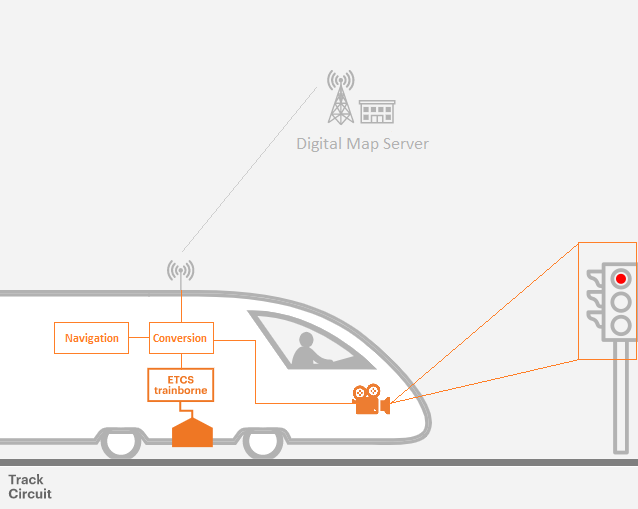
Benefits of ETCS Level 1 virtual are simple:
- Providing visual Automatic Train Protection, potentially enhancing the safety of railway operations on lines fitted with a legacy ATP, and on lines not equipped with a legacy ATP at all.
- Enabling the use of automatic driving, ATO over ETCS, on all lines equipped with lineside signalling. This is a huge benefit and reason for railway undertakings to equip existing rolling stock with ERTMS/ETCS. Specially to benefit from energy savings in a tense energy context in Europe in 2023.
ETCS Level 1 virtual could be a game-changer by initiating an important onboard rollout of ERTMS/ETCS. Railway undertakings would have direct benefits by doing so. This concept is also a migration tool towards ERTMS/ETCS Level 3 and ATO up to GoA4. Indeed, the trains would already been equipped with onboard ERTMS/ETCS, Localization, Perception, and a radio module (GSM-R/FRMCS). All these elements are necessary for Level 3 and/or ATO up to GoA4.
The certification challenge
ETCS supervision means safety. Today, ETCS systems onboard and trackside are safe and certified. The starting assumptions of the studied system are following :
- Trackplan static data are safe,
- The localization device is safe,
- The perception and conversion devices are safe,
To create and maintain the trackplan data is not something new : it is already done when ERTMS/ETCS is deployed. However, for lineside signals, the difficulty might be in the obtention of their characteristics and the uncertainties associated.
Suppliers will have the challenge to develop safe localization and perception devices.
Conclusion
The standard solution ATO over ETCS works only with ERTMS/ETCS both onboard and trackside. However, the long ERTMS/ETCS rollout is delaying the adoption of ATO over ETCS. Meanwhile, ATO over ETCS will integrate the 2022 revision of the Technical Specification for Interoperability – Control Command and Signalling. Once adopted by UE state members, this TSI will impose ATO over ETCS as unique solution to grant interoperability and interchangeability.
The 2022 energy crisis, very impacting for rail competitiveness, is a threat to the modal shift towards rail. ATO over ETCS, thanks to its energy savings, is a solution to a tangible problem. However, its necessity to use ERTMS/ETCS and especially the trackside part of it, delays the adoption of ATO over ETCS, as ERTMS/ETCS rollout takes time and money.
To face this issue, migration solutions are investigated by railway undertakings. The use of existing systems, abstracted by an ATO-ADAPTOR delivering SUBSET-130, has been tested by NS helped by CAF SIGNALLING and Prorail. In France, ATO over ETCS has been tested by SNCF, ALSTOM and HITACHI, using lineside perception and interpretation.
A standard solution is being investigated at European level, enabling the use of ATO over ETCS, on lines that are not yet equipped with ERTMS/ETCS. One possibility is to define new onboard ETCS functions, fed by lineside signalling perception and conversion devices. This concept can be understood as a new approach to ETCS Level 1 acquisition of lineside signals states, totally onboard. The project opens a decoupling between ETCS-Onboard and ETCS-Trackside, making possible ATO over ETCS-Onboard on any track equipped with lineside signalling.
This concept present noticeable advantages :
- Train protection with ETCS, based on lineside signalling perception and interpretation. Therefore, onboard class B system can be decommissioned.
- As side effect, railway undertakings can be tempted to install this system instead of national systems/STMs to access a foreign network. The augmentation of ETCS-equipped rolling stock become a mean to invite the infrastructure manager to deploy ETCS trackside, especially level 3 when available.
- Automatic driving using ATO over ETCS without any adapters is possible.
This approach presents one significant blind spot : its impact on ERTMS/ETCS and SUBSET-026 specification. This modification will have to be studied by ERTMS stakeholders. The time needed for this investigation is incompatible with the emergency of 2022 energy crisis.
Hence, a GoA2 ATO over ETCS solution, based on lineside signalling perception and interpretation, using an ATO-ADAPTER to provide SUBSET-130, could be a good match. Train protection would still be done by class B systems, but without any connection to the automatic driving system. This incremental approach prepares the railway undertaking for a future onboard ERTMS/ETCS equipment.
To discover the european train control system ERTMS/ETCS, a key element of the autonomous train, I invite you to read this article !
To go further
ERTMS/ETCS specifications : available in the library.
ATO over ETCS (GoA2) specifications : available in the library.
Références :
[1] https://www.railtech-europe.com/wp-content/uploads/2021/03/Lammert-Visser-NS.pptx.pdf
[2] https://uic.org/events/uic-irs-90940-sfera-launch
[3] https://www.digital.sncf.com/actualites/train-autonome-lenjeu-de-la-detection-et-de-la-signalisation
[4] https://cordis.europa.eu/project/id/101014984/fr
[5] https://www.lettreducheminot.fr/fret/lassociation-francaise-du-rail-craint-un-retour-en-arriere-pour-le-fret-ferroviaire/
[6] https://www.linkedin.com/posts/carlo-m-borghini-he-him-1973925_ai-europe-innovation-activity-6931855923745333248-tf8n/?utm_source=share&utm_medium=member_desktop
